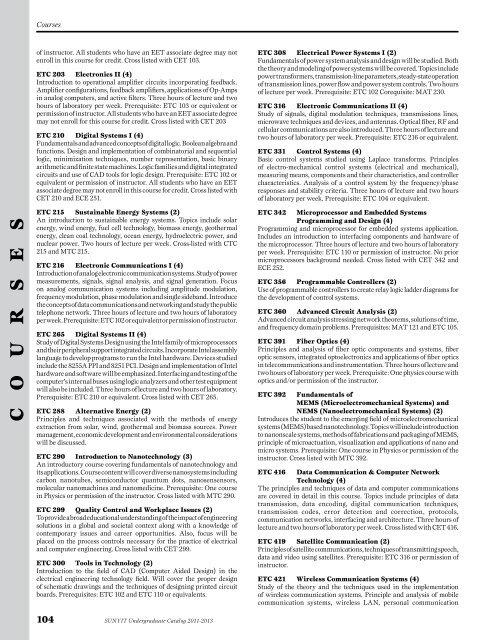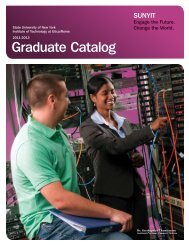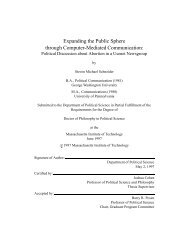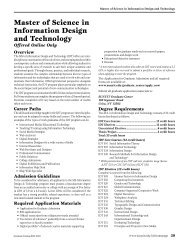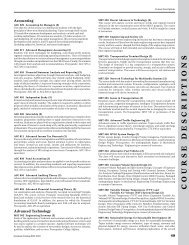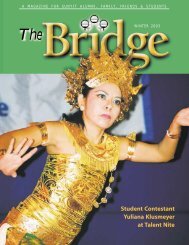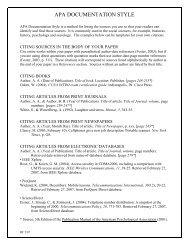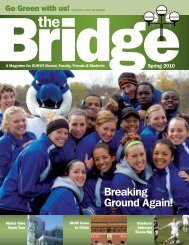Undergraduate Catalog 2011-2013 - SUNY Institute of Technology
Undergraduate Catalog 2011-2013 - SUNY Institute of Technology
Undergraduate Catalog 2011-2013 - SUNY Institute of Technology
Create successful ePaper yourself
Turn your PDF publications into a flip-book with our unique Google optimized e-Paper software.
Courses<br />
<strong>of</strong> instructor. All students who have an EET associate degree may not<br />
enroll in this course for credit. Cross listed with CET 103.<br />
ETC 203 Electronics II (4)<br />
Introduction to operational amplifier circuits incorporating feedback.<br />
Amplifier configurations, feedback amplifiers, applications <strong>of</strong> Op‐Amps<br />
in analog computers, and active filters. Three hours <strong>of</strong> lecture and two<br />
hours <strong>of</strong> laboratory per week. Prerequisite: ETC 103 or equivalent or<br />
permission <strong>of</strong> instructor. All students who have an EET associate degree<br />
may not enroll for this course for credit. Cross listed with CET 203<br />
ETC 210 Digital Systems I (4)<br />
Fundamentals and advanced concepts <strong>of</strong> digital logic. Boolean algebra and<br />
functions. Design and implementation <strong>of</strong> combinatorial and sequential<br />
logic, minimization techniques, number representation, basic binary<br />
arithmetic and finite state machines. Logic families and digital integrated<br />
circuits and use <strong>of</strong> CAD tools for logic design. Prerequisite: ETC 102 or<br />
equivalent or permission <strong>of</strong> instructor. All students who have an EET<br />
associate degree may not enroll in this course for credit. Cross listed with<br />
CET 210 and ECE 251.<br />
ETC 308 Electrical Power Systems I (2)<br />
Fundamentals <strong>of</strong> power system analysis and design will be studied. Both<br />
the theory and modeling <strong>of</strong> power systems will be covered. Topics include<br />
power transformers, transmission-line parameters, steady-state operation<br />
<strong>of</strong> transmission lines, power flow and power system controls. Two hours<br />
<strong>of</strong> lecture per week. Prerequisite: ETC 102 Corequisite: MAT 230.<br />
ETC 316 Electronic Communications II (4)<br />
Study <strong>of</strong> signals, digital modulation techniques, transmissions lines,<br />
microwave techniques and devices, and antennas. Optical fiber, RF and<br />
cellular communications are also introduced. Three hours <strong>of</strong> lecture and<br />
two hours <strong>of</strong> laboratory per week. Prerequisite: ETC 216 or equivalent.<br />
ETC 331 Control Systems (4)<br />
Basic control systems studied using Laplace transforms. Principles<br />
<strong>of</strong> electro‐mechanical control systems (electrical and mechanical),<br />
measuring means, components and their characteristics, and controller<br />
characteristics. Analysis <strong>of</strong> a control system by the frequency/phase<br />
responses and stability criteria. Three hours <strong>of</strong> lecture and two hours<br />
<strong>of</strong> laboratory per week. Prerequisite: ETC 104 or equivalent.<br />
C O U R S E S<br />
ETC 215 Sustainable Energy Systems (2)<br />
An introduction to sustainable energy systems. Topics include solar<br />
energy, wind energy, fuel cell technology, biomass energy, geothermal<br />
energy, clean coal technology, ocean energy, hydroelectric power, and<br />
nuclear power. Two hours <strong>of</strong> lecture per week. Cross-listed with CTC<br />
215 and MTC 215.<br />
ETC 216 Electronic Communications I (4)<br />
Introduction <strong>of</strong> analog electronic communication systems. Study <strong>of</strong> power<br />
measurements, signals, signal analysis, and signal generation. Focus<br />
on analog communication systems including amplitude modulation,<br />
frequency modulation, phase modulation and single sideband. Introduce<br />
the concepts <strong>of</strong> data communications and networking and study the public<br />
telephone network. Three hours <strong>of</strong> lecture and two hours <strong>of</strong> laboratory<br />
per week. Prerequisite: ETC 102 or equivalent or permission <strong>of</strong> instructor.<br />
ETC 265 Digital Systems II (4)<br />
Study <strong>of</strong> Digital Systems Design using the Intel family <strong>of</strong> microprocessors<br />
and their peripheral support integrated circuits. Incorporate Intel assembly<br />
language to develop programs to run the Intel hardware. Devices studied<br />
include the 8255A PPI and 8251 PCI. Design and implementation <strong>of</strong> Intel<br />
hardware and s<strong>of</strong>tware will be emphasized. Interfacing and testing <strong>of</strong> the<br />
computer’s internal buses using logic analyzers and other test equipment<br />
will also be included. Three hours <strong>of</strong> lecture and two hours <strong>of</strong> laboratory.<br />
Prerequisite: ETC 210 or equivalent. Cross listed with CET 265.<br />
ETC 288 Alternative Energy (2)<br />
Principles and techniques associated with the methods <strong>of</strong> energy<br />
extraction from solar, wind, geothermal and biomass sources. Power<br />
management, economic development and environmental considerations<br />
will be discussed.<br />
ETC 290 Introduction to Nanotechnology (3)<br />
An introductory course covering fundamentals <strong>of</strong> nanotechnology and<br />
its applications. Course content will cover diverse nanosystems including<br />
carbon nanotubes, semiconductor quantum dots, nanosensensors,<br />
molecular nanomachines and nanomedicine. Prerequisite: One course<br />
in Physics or permission <strong>of</strong> the instructor. Cross listed with MTC 290.<br />
ETC 299 Quality Control and Workplace Issues (2)<br />
To provide a broad educational understanding <strong>of</strong> the impact <strong>of</strong> engineering<br />
solutions in a global and societal context along with a knowledge <strong>of</strong><br />
contemporary issues and career opportunities. Also, focus will be<br />
placed on the process controls necessary for the practice <strong>of</strong> electrical<br />
and computer engineering. Cross listed with CET 299.<br />
ETC 300 Tools in <strong>Technology</strong> (2)<br />
Introduction to the field <strong>of</strong> CAD (Computer Aided Design) in the<br />
electrical engineering technology field. Will cover the proper design<br />
<strong>of</strong> schematic drawings and the techniques <strong>of</strong> designing printed circuit<br />
boards. Prerequisites: ETC 102 and ETC 110 or equivalents.<br />
ETC 342 Microprocessor and Embedded Systems<br />
Programming and Design (4)<br />
Programming and microprocessor for embedded systems application.<br />
Includes an introduction to interfacing components and hardware <strong>of</strong><br />
the microprocessor. Three hours <strong>of</strong> lecture and two hours <strong>of</strong> laboratory<br />
per week. Prerequisite: ETC 110 or permission <strong>of</strong> instructor. No prior<br />
microprocessors background needed. Cross listed with CET 342 and<br />
ECE 252.<br />
ETC 356 Programmable Controllers (2)<br />
Use <strong>of</strong> programmable controllers to create relay logic ladder diagrams for<br />
the development <strong>of</strong> control systems.<br />
ETC 360 Advanced Circuit Analysis (2)<br />
Advanced circuit analysis stressing network theorems, solutions <strong>of</strong> time,<br />
and frequency domain problems. Prerequisites: MAT 121 and ETC 105.<br />
ETC 391 Fiber Optics (4)<br />
Principles and analysis <strong>of</strong> fiber optic components and systems, fiber<br />
optic sensors, integrated optoelectronics and applications <strong>of</strong> fiber optics<br />
in telecommunications and instrumentation. Three hours <strong>of</strong> lecture and<br />
two hours <strong>of</strong> laboratory per week. Prerequisite: One physics course with<br />
optics and/or permission <strong>of</strong> the instructor.<br />
ETC 392 Fundamentals <strong>of</strong><br />
MEMS (Microelectromechanical Systems) and<br />
NEMS (Nanoelectromechanical Systems) (2)<br />
Introduces the student to the emerging field <strong>of</strong> microelectromechanical<br />
systems (MEMS) based nanotechnology. Topics will include introduction<br />
to nanonscale systems, methods <strong>of</strong> fabrications and packaging <strong>of</strong> MEMS,<br />
principle <strong>of</strong> microactuation, visualization and applications <strong>of</strong> nano and<br />
micro systems. Prerequisite: One course in Physics or permission <strong>of</strong> the<br />
instructor. Cross listed with MTC 392.<br />
ETC 416 Data Communication & Computer Network<br />
<strong>Technology</strong> (4)<br />
The principles and techniques <strong>of</strong> data and computer communications<br />
are covered in detail in this course. Topics include principles <strong>of</strong> data<br />
transmission, data encoding, digital communication techniques,<br />
transmission codes, error detection and correction, protocols,<br />
communication networks, interfacing and architecture. Three hours <strong>of</strong><br />
lecture and two hours <strong>of</strong> laboratory per week. Cross listed with CET 416.<br />
ETC 419 Satellite Communication (2)<br />
Principles <strong>of</strong> satellite communications, techniques <strong>of</strong> transmitting speech,<br />
data and video using satellites. Prerequisite: ETC 316 or permission <strong>of</strong><br />
instructor.<br />
ETC 421 Wireless Communication Systems (4)<br />
Study <strong>of</strong> the theory and the techniques used in the implementation<br />
<strong>of</strong> wireless communication systems. Principle and analysis <strong>of</strong> mobile<br />
communication systems, wireless LAN, personal communication<br />
104 <strong>SUNY</strong>IT <strong>Undergraduate</strong> <strong>Catalog</strong> <strong>2011</strong>-<strong>2013</strong>


